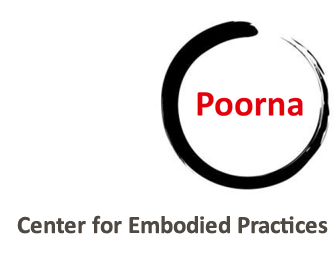
What is Somatics?
Somatics is derived from the Greek word ‘soma’, meaning ‘the body in its wholeness’. The somatic practice being developed by Navtej at Abhyas, involves methods of scanning and mapping the body in a very detailed manner, that is, understanding the physical structure of the skeleton, the size, shape and weight of the bones, the contours of the joints, the elasticity of the ligaments, the strength, tautness and slackness of the muscles, the nature of bodily substances, fluids and airs that pervade the body, and finally a sophisticated understanding of dynamics. The inherent emotionality of the material body lies at the core of this practice. The approach views the materiality of the body as not only intelligent but also endowed with autonomous will, tendencies, ‘feeling’, and intention; and thereby understands dynamics of the body as not only mechanical but even “emotional”.
The Abhyas Model:
The Abhyas somatic technique models itself upon the yogic vision of the body, a body made up of the five elements (bhootas), comprising of gunas, doshas, vayus, energies, and their inherent proclivities. In particular it draws its inspiration from the component of sukha or pleasurable repose that can be methodically orchestrated and subsequently allowed to pervade the body in savasana at the end of an asana routine. The somatic practice relies on this sensorial sukha for the mind to reposefully attend upon sensation and unhurriedly hover and register subtle responses of the body. The idea of this method is to creatively incorporate these self-orchestrated responses into crafting an authentic movement vocabulary.
How does a practitioner benefit from the somatic practice?
Movement autonomy is central to the somatic practice at Abhyas. The idea is to detect and then refine the autonomous ‘intention’ or response to move. Instead of making the performers/practitioners subject to the dictates of form and the convention of aesthetics—which are superimposed upon the body in the case of formal techniques of embodied practices—the somatic practice aims to make the performative body thrive on its own sensitivity. And it hopes that this self-reliance will foster a “sensory authority” which in turn may promote movement autonomy in the mover!
As much as a performer can benefit from this practice, so can a non-performer. The focus given to breath, voice, touch, gaze, attention, and intent, all come together towards building an awareness and sensitivity and hence immensely enhance mental, physical, and emotional health as well as the creativity of an individual; many a times also leading to a knowledge of self-healing.
Components of the Course:
It is six-month training course. The course will be taught twice a week, and the duration of each session will be one and a half hours. The first half of the session will comprise training, and second half will concentrate on movement and choreography. The chief components of the course are as follows:
B.A.R.P.S Method
Choreography Tools and Methodologies
Training in Reading/Writing body and movement
Monthly conversations and workshops with experts from various artistic practices
The course aims to culminate in devised performance piece to, tentatively scheduled to be showcased in the end of April, 2018.


 |
 |
 |
 |
 |
Website Designed and Developed by www.mark-design.net